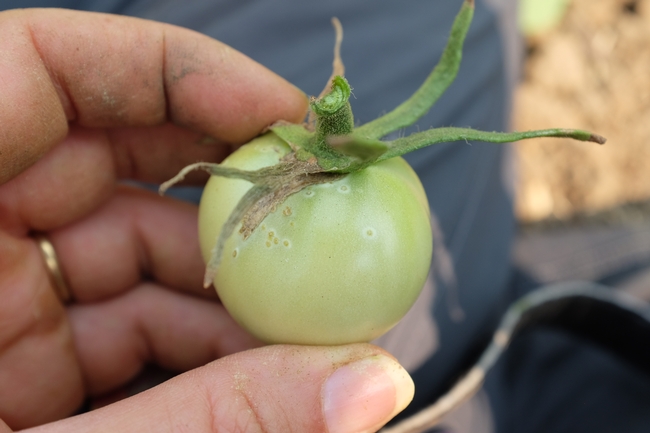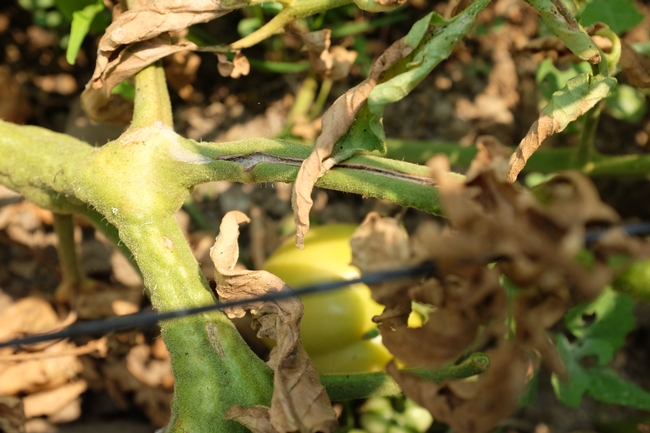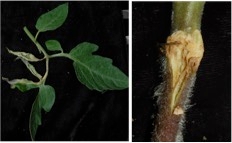Bacterial Wilt and Canker in Field-Grown Tomatoes in California
Clavibacter michiganensis subspecies michiganensis (Cmm)
Bacterial canker has periodic outbreaks that can cause significant damage in a single season from primary and secondary spread. It is a vascular disease of tomato that spreads easily during the season by superficial movement of the bacterium via workers and equipment. This disease causes loss of photosynthetic surface, wilting, premature death and unmarketable fruit. Control and management relies primarily on clean seed, healthy transplant practices, sanitation, and crop rotation.
SYMPTOMS
All plant stages are susceptible, though initial infection typically starts at the seedling stage. As seedlings, small, white raised spots may occur on the leaves, wilting and possibly death. However, disease may not develop in infected seedlings until conditions are more optimal, resulting in asymptomatic infected seedlings that get planted.
Early symptoms in-field include wilting, curling of leaflets and browning of leaves. Due to the vascular location of the organism, symptoms are often limited to one side of the plant. Early infection can be difficult to diagnose based on symptoms alone, but vigilance is important to minimize spread. Therefore, diagnosis of suspect plant material by a lab or a highly sensitive and effective in-field diagnosis kit is suggested.
Leaf symptoms are often called ‘firing' due to the scorched appearance and rapid development. Initial appearance is yellow to tan patches between veins, ¼ inch diameter on the upper leaf surface of mature leaves. The leaf margin turns brown with a yellow border. As the leaves die, the petioles remain green and firmly attached to the stem.
Fruit symptoms are small (? inch), creamy white spots with tan/brown centers found on the upper, exposed parts of the fruit. These characteristic ‘Bird's-eye spots' may eventually become brown, necrotic and merge with other spots. Fruit symptoms can be observed at any stage, but are usually seen on green fruit ½ to 2” diameter.
Vascular discoloration, initially yellow, then light brown to reddish, can also be seen in the stem and petiole. Pith appears dry and mealy, as well as discolored. Yellow sticky fluid may emerge from cut stem when squeezed. Stems can split open, forming cankers that facilitate secondary spread.
Whole plant wilting begins with the lower leaves but travels up the stem. Infection tends to be more severe in plants infected early, as seedlings, versus late in their growth cycle due to secondary spread.



BIOLOGY and EPIDEMIOLOGY
Disease development is favored by warm (75-90°F), moist conditions. Greenhouse operations are highly susceptible to disease development.
Initial inoculum can come from several sources, including infected plant debris in soil, infected weed hosts, infected volunteer tomato plants, diseased transplants, contaminated wood stakes, and infested seed. Clean seed is very important, for disease can develop and spread rapidly under greenhouse conditions, and a 1% seed transmission rate is sufficient to give 100% disease. In-field spread occurs easily by workers' hands, equipment, during vine pruning, particularly when plants are moist with dew or irrigation water. Bacteria present in and on the plant can be transmitted to adjacent plants by pruning or abrasion wounds, or simply contact with infected leaves, entering through pores on the leaf margin (hydathodes) which links directly to the plant xylem vasculature.
Cmm can survive as free-living bacteria in soil for short periods, in non-decomposed tomato plant debris, on weed hosts (nightshade) and volunteer tomato/pepper plants, on contaminated stakes or equipment and in association with seed. Volunteer plants from a previous infection or susceptible weeds can maintain low levels of the pathogen. It survives better in cool, dry conditions than in hot, moist conditions.
CONTROL
Bacterial canker can be challenging to control because of challenges with early detection, the highly infectious nature of the disease, and the number of inoculum sources. Sanitation and preventative measures must be enforced.
- Use certified, disease-free seed from canker-free plants. The standard hydrochloric acid method or fermentation process should produce clean seed. However, these methods will not treat embryonic infection. Centrifuge extraction can lead to high levels of seed contamination.
- Certified disease-free transplants. It is not usually possible to identify infected seedlings at the time of transplanting.
- Remove disease plants as soon as possible. If infection occurs early in the season, infected areas should be plowed down to prevent spread to nearby healthy fields. Several healthy plants adjacent to symptomatic plants should also be removed.
- Hands, tools, shoes and crop support materials should all be disinfected. Hypochlorite (bleach) is not satisfactory as a disinfectant. Quartenary ammonium compounds are recommended.
- Copper-fungicide compounds in foliar sprays are not highly effective for bacterial canker control because they only act at the tissue surface while many of the bacteria are internal to the plant. Sprays should not be applied at high pressure as this may damage the plant (causing many micro-wounds) and lead to more disease. Fixed copper field sprays may help in protecting healthy plants, especially if only superficial symptoms are present.
- When leaves are moist with irrigation water or dew, do not allow movement through the field by workers or equipment
- Remove or plow in infected plants as soon as possible after harvest in order to ensure good decomposition. The bacterium cannot survive in soil for long, but can survive in the field in complex with plant material.
- Discard wooden stakes and strings from infected areas. The porous condition of wood makes sanitation imperfect.
- Rotate out of tomato, peppers, eggplant and related crops for 2-3 years
- Control Solanaceous weeds and volunteer tomatoes and peppers.
- There are currently no resistant tomato varieties for bacterial canker
REFERENCES
Koike, S., P. Gladders, and A. Paulus. (2007) Vegetable Diseases: A Colour Handbook. Boca Raton, FL: CRC Press.
http://vegetablemdonline.ppath.cornell.edu/factsheets/Tomato_Bacterial.htm#Click
https://extension.umn.edu/plant-diseases/bacterial-canker-tomato
Dr. Sally Miller, Dr. Ruguo Huang Bacterial canker of tomato, Asta: A commercial growers guide.
Jones, J. B., T. Zitter, M. T. Momol, and S. A. Miller. 2014. Compendium of Tomato Diseases and Pests, Second Edition. St. Paul, Minnesota: The American Phytopathological Society.
Special thanks to input from Dr. Gitta Coaker and Dr. Cassandra Swett.
Attached Files: